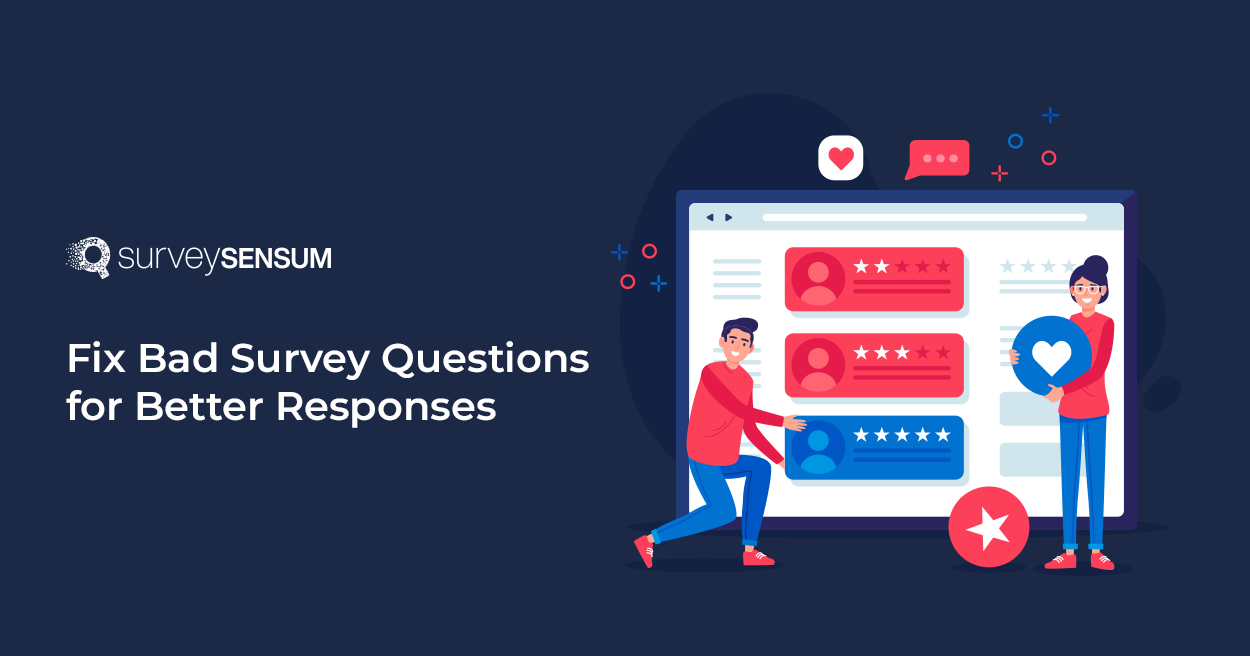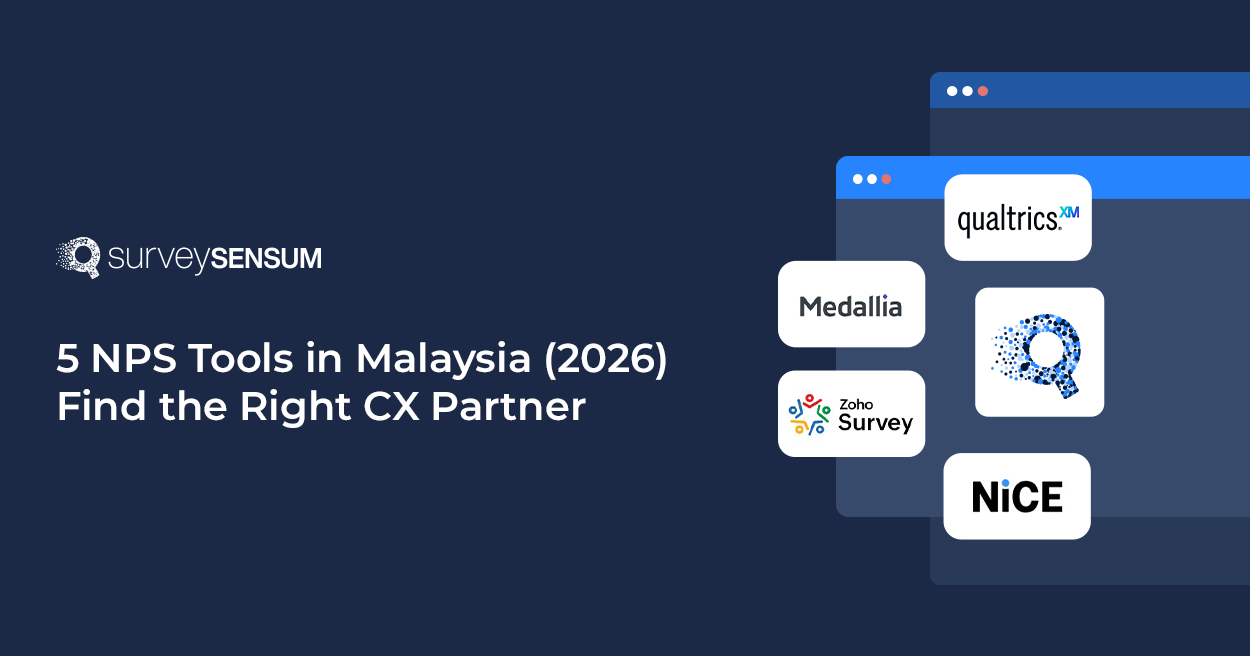

“There are no right answers to wrong questions.” – Ursula K. Le Guin. As far as customer surveys are concerned, this couldn’t be any closer to the truth.
Surveys can provide us with so much insight into what your customers want and are thinking, but they can become a liability if the questions asked are flawed.
One of the biggest issues? Biased or poorly framed questions.
Customer feedback is hard to come by, so when you do get it, every response counts. Bad survey questions not only waste valuable opportunities to learn but can also mislead you into making poor decisions.
In this blog post, we’ll cover what are bad survey questions, how to spot them, get examples, and offer tips to fix them for more accurate, actionable insights from your customers.
What Are Bad Survey Questions?
A bad survey question is essentially a poorly formed question that stops you from getting honest, objective answers from your respondents. Usually, biased or leading language nudges your customers into a particular response over letting them speak their truth and experience.
For instance, “Would you agree that our new app is way better than the old one?” This question also implies this new app is better, and may cause the respondent to agree even if they didn’t.
Bad survey questions are a major source of survey bias and can really hurt the quality of feedback you collect. And when that happens, your survey stops being an effective tool for gathering customer insights.
Now that we know the ‘what,’ let’s see how to identify them!
How to Identify Bad Survey Questions?
Identifying bad survey questions is essential for collecting accurate and actionable feedback that reflects your customers’ experiences. Poorly crafted questions can distort data, leading to misguided decisions and missed opportunities for improvement. Here’s how to spot those pitfalls:
- Asking too much information at once can overwhelm respondents and lead to incomplete or inaccurate answers.
- Watch for questions that push respondents toward a specific answer. For instance, asking, “How delighted are you with our outstanding store atmosphere?” pushes them toward a positive response, even if they don’t feel that way.
- Avoid questions that are unclear, complicated, or confusing, as they can lead to misunderstandings.
- Recognize leading questions that suggest what the answer should be as they may not accurately capture respondents’ true opinions.
- Using absolute questions (e.g., “Do you always…”) restricts the range of answers people can give.
- Look out for answer options that overlap. For instance, ‘Which of the following do you prefer: ‘Online Support’ or ‘Customer Service?’ These categories overlap, as online support is part of customer service, confusing respondents.
In the next section, we will cover five types of bad survey questions with examples and fixes.
5 Types of Bad Survey Questions You Must Steer Clear From
The first step to collecting meaningful feedback is knowing what type of bad survey questions it may be. Each type can introduce specific biases or confusion, undermining the reliability of your data. Let’s explore them.
1. Leading Questions
What Is It?
Leading questions introduce (or imply or insinuate) a particular answer that directs the respondent toward a particular response rather than an honest response. Often, businesses include questions based on what they think is already true or assume their beliefs are facts. This can push customers to give answers that align with those expectations instead of letting them freely share what they really think.
Leading questions can be unintentional—but if they come across as manipulative, they can result in a higher survey drop-off rate, a negative view of your company, or a skewed set of responses. Of all these outcomes, anyone can deeply damage the effectiveness of your customer experience program.
Examples of Leading Questions & How to Fix Them:
| Incorrect Question | Correct Question |
| Would you say that our product XYZ is better than its competitors? | How would you compare our product XYZ to its competitors? |
| This question assumes that Product XYZ is better, which biases the respondent and limits their ability to provide neutral feedback. |
How to Fix Leading Questions?
To craft a survey, come up with questions that are phrased objectively and offer an answer scale with balanced opposites, negative and positive. It also gives honest feedback that is crucial to learn from without any bias on the input that you receive.
2. Vague or Ambiguous Questions
What Is It?
Vague questions can create a lack of clarity or specificity, and the respondent won’t know what is being asked. Jargon or complex grammar can contribute to this vagueness, resulting in questions that can be interpreted in multiple ways.
Examples of Vague Questions & How to Fix Them:
| Incorrect Question | Correct Question |
| Are you using our product often? | How frequently do you use our product? (e.g., daily, weekly, monthly) |
| Without specifying a time frame, there is room for confusion regarding the frequency of use. |
How to Fix Vague or Ambiguous Questions?
Ensure your questions clearly define the context or aspect you’re inquiring about. Be sure to frame questions with enough context to guide respondents and avoid jargon and complex phrasing.
Avoid the pitfalls of vague questions! SurveySensum empowers you to deploy focused surveys that capture valuable customer insights quickly with pre-built templates.
3. Double-Barreled Questions
What Is It?
A double-barreled question is when you combine two different queries into one statement and have respondents answer two or more issues all at once. Most of the time, this type of question causes confusion and unreliable feedback because it asks for two different things with one box to respond to.
Double-barreled questions are often tied together with conjunctions such as ‘and’ or ‘or’. Although asking two questions at once may seem like a way to save time, it will actually compromise the quality of your survey results.
Examples of Double-Barreled Questions & How to Use Them:
| Incorrect Question | Correct Question |
| Have you been pleased with our product and our customer service? |
|
| This question can be taken as two separate inquiries – product satisfaction and customer service satisfaction—and mixed together. Each one may weigh differently on respondents, so it’s hard to know how they feel. |
How to Fix Double-Barreled Questions?
First, look at your survey questions. Search for conjunctions ‘and’ or ‘or’ in any question. That means these often indicate that you are asking about more than one topic at a time. Ensure that each question serves a single purpose. Ask yourself what specific feedback you need and design your questions accordingly. This helps in gathering focused and actionable insights.
4. Double Negatives Questions
What Is It?
A double negative occurs when two negative words are used in the same sentence, which makes the sentence confusing and difficult to understand. Negative adverbs and other negative words combined with words like ‘not,’ ‘no,’ or ‘un-‘ are a recipe for this. Questions can be harder with double negatives than they have to be, and communication can become cloudier.
Examples of Double Negative Questions & How to Fix Them:
| Incorrect Question | Correct Question |
| Did you not dislike the customer service experience? | Did you like the customer service experience? |
| This question is confusing because of the “not dislike” phrasing. Respondents have to mentally reverse the meaning to give an answer, which could lead to errors. |
How to Fix Double Negative Questions?
To get rid of a double negative you need to rephrase the question in a positive or neutral tone. Look out for negative adverbs or prefixes (negative adverbs include such words as ‘barely,’ ‘scarcely’; prefixes include ‘un-‘ and ‘non-‘) and the pairs of words including them. Simply change it to make the question clear or remove one of the negatives.
5. Poor Answer Scales
What Is It?
An answer scale is poor when the options offered to respondents are inadequate in reflecting the spectrum of responses that can be made. However, if the answer scale is unbalanced, poorly worded, or improperly formatted, it produces biased or unclear results. These flawed scales might cause respondents to give some answers rather than others, or not offer all of the choices available to accurately respond.
Examples of Poor Answer Scales & How to Fix Them
| Incorrect Scale | Correct Question |
|
How satisfied are you with our service?
Scale: (Satisfied/Neutral/Dissatisfied)
|
How satisfied are you with our service?
Scale: Very Satisfied, Satisfied, Neutral, Unsatisfied, Very Unsatisfied
|
| This scale is unbalanced, missing middle-ground options like “Very Satisfied” or “Somewhat Satisfied,” which could skew results. |
How to Fix Poor Answer Scales?
Use common scales that are easy to understand, allowing respondents to respond either numerically or with labels, such as 1–5 or 1–10. It prevents respondents from being made to go to extremes and make more nuanced answers. The scale should, if it’s possible, have an equal number of positive and negative responses with a neutral middle point.
What Makes a Good Survey Question?
A good survey question is simply a question that is clear, short, and easy to understand so that respondents can respond truthfully without confusion. First of all, to make survey questions effective, start by matching the format of your survey questions with your data collection goals. Here are key points to keep in mind:
- Keep questions short and straightforward to avoid survey fatigue and make them mobile-friendly.
- If you use rating scales, keep them the same throughout the survey.
- Provide clear instructions on how to answer the questions, especially for rating scales or specific formats.
- Ensure your questions are pertinent to all segments of your target audience, or you risk disengagement.
- Ask precise questions to get focused answers. Instead of “What do you think?” try “What do you think about our new product?”
- Keep the survey short and to the point. Long surveys can lead to respondent fatigue.
- Offer a complete spectrum of answer options so you don’t limit people’s responses and keep your data as inclusive as possible.
- Encourage detailed feedback with open-ended questions like, “What suggestions do you have for us?”
Applying this will make your survey questions honest and valuable so that you can do meaningful analysis.
Wrapping Up
Developing effective surveys can be challenging, as a single incorrect question can result in distorted data and incorrect customer feedback interpretation. What if you had a trusted ally to help you shape the right questions and avoid the most common pitfalls? SurveySensum is the ultimate customer feedback tool that helps you create your survey quickly and efficiently and gather high-quality data.
You will not have to start creating your own survey from scratch with customized industry-specific survey templates and pre-designed questions from SurveySensum. After you’ve distributed your surveys, SurveySensum provides powerful data analysis tools that help turn feedback into actionable insights.
So why settle for mediocre surveys? Elevate your approach today with SurveySensum and listen closely to the voice of your customers!















